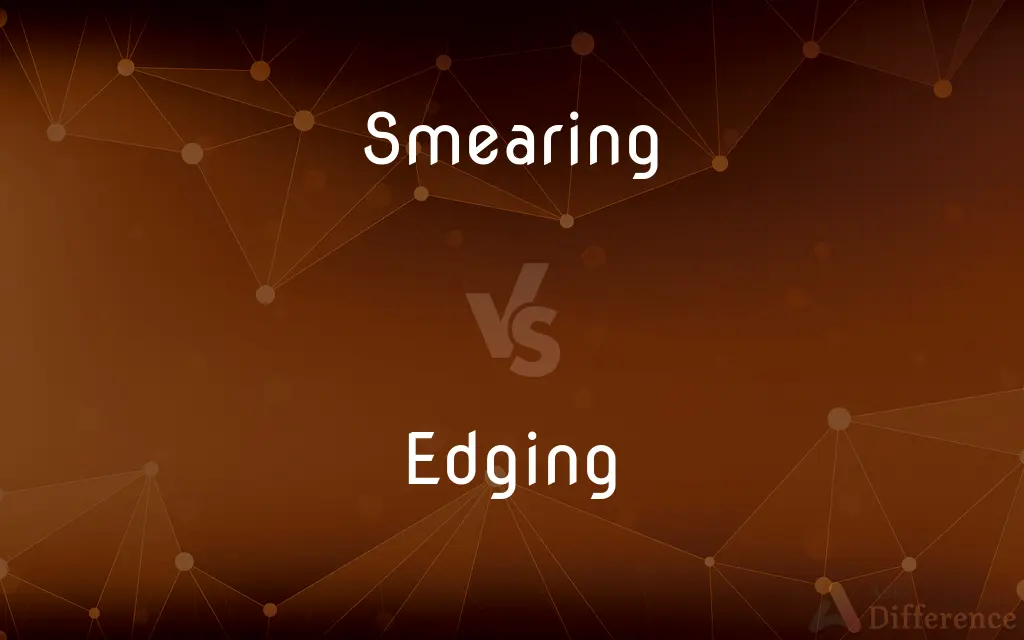Smearing vs. Edging — What's the Difference?
By Urooj Arif & Fiza Rafique — Updated on April 4, 2024
Smearing involves using the foot's surface for friction on rock, while edging uses the shoe's edge on small holds.

Difference Between Smearing and Edging
Table of Contents
ADVERTISEMENT
Key Differences
Smearing in rock climbing is a technique that relies on the friction between a climber's shoe and the rock surface, using as much of the sole's flat surface as possible. This method is particularly effective on slabs or smooth surfaces where there are no distinct footholds. On the other hand, edging leverages the edge of the climbing shoe to stand on small rock features or edges, requiring precise foot placement and balance.
Smearing demands a flexible shoe to maximize the contact area between the shoe and rock, enhancing friction and support. Climbers must trust their shoe's rubber and their body's balance to smear effectively. Conversely, edging benefits from a stiffer shoe that supports the climber's weight on small holds, allowing for more precise movements and less foot fatigue over time.
The technique of smearing is often used in situations where balance and weight distribution are crucial, as it allows climbers to maintain stability on less-defined surfaces. Climbers must spread their weight evenly and use their lower body strength to press into the rock. In contrast, edging focuses on pinpoint accuracy, with climbers positioning their feet so that the shoe's edge catches tiny protrusions or ledges, often shifting their body weight to optimize leverage and reach.
In terms of skill level, smearing can be intuitive for beginners but mastering it requires understanding of how to effectively distribute one's weight and use friction. Edging, while also accessible to beginners, demands more precision and awareness of foot placement, making it a skill that continues to be refined at all levels of climbing.
Despite their differences, both smearing and edging are essential skills in a climber's repertoire, adaptable to various types of rock and climbing styles. Climbers often switch between the two techniques based on the terrain, showcasing the importance of versatility and skill in overcoming climbing challenges.
ADVERTISEMENT
Comparison Chart
Technique
Uses foot's surface for friction
Uses shoe's edge on small holds
Shoe Type
Flexible for maximum contact
Stiff for supporting weight
Application
Effective on slabs/smooth surfaces
Useful for precise footwork on edges
Skill Focus
Balance and weight distribution
Precision and foot placement
Skill Level
Intuitive but requires mastery
Demands precision, refined at all levels
Compare with Definitions
Smearing
A climbing technique using the shoe's flat surface for friction.
Smearing helps climbers ascend smooth rock faces where no clear footholds exist.
Edging
Continuously refined by climbers of all levels.
Even advanced climbers work on perfecting their edging technique.
Smearing
Relies on the rubber's friction and climber's balance.
Effective smearing requires trusting your shoes' grip on the rock.
Edging
Utilizing the edge of the climbing shoe to stand on small holds.
Edging allows climbers to utilize tiny rock features effectively.
Smearing
Suitable for slab climbing and featureless surfaces.
On that slab route, smearing was key to maintaining upward progress.
Edging
Demands precise footwork and balance.
Successful edging on that technical section required exact foot placement.
Smearing
Focuses on weight distribution.
Proper smearing technique involves spreading your weight evenly across your foot.
Edging
Requires stiff shoes for support and precision.
My edging improved after switching to stiffer climbing shoes.
Smearing
Demands flexible climbing shoes.
Climbers often choose softer shoes for routes that require a lot of smearing.
Edging
Essential for routes with small footholds.
The route was filled with tiny ledges, making edging crucial for ascent.
Smearing
To spread or daub (a surface, for example) with a sticky, greasy, or dirty substance.
Edging
Something that forms or serves as an edge or border.
Smearing
To apply by spreading or daubing
Smeared suntan lotion on my face and arms.
Edging
Present participle of edge
Smearing
To cause to be blurry or spread in unwanted places
The ink on the poster was smeared.
Edging
Anything that forms, defines, or marks the edge of something.
The decorative edging around the door makes it easier to find in the dark.
Smearing
To stain or attempt to destroy the reputation of; vilify
Political enemies who smeared his name.
Edging
(rock climbing) A technique involving the placement of the edge of the climbing shoe on a sharp hold.
Smearing
(Slang) To defeat utterly.
Edging
The operation of shaping or dressing the edge of anything, as of a piece of metal.
Smearing
To spread easily in an undesired way
This mascara smears when it gets wet.
Edging
The sexual technique of maintaining a high level of sexual arousal for an extended period of time without reaching orgasm.
Smearing
A mark made by smearing; a spot or blot.
Edging
That which forms an edge or border, as the fringe, trimming, etc., of a garment, or a border in a garden.
Smearing
A substance to be spread on a surface.
Edging
The operation of shaping or dressing the edge of anything, as of a piece of metal.
Smearing
(Biology) A sample, as of blood or bacterial cells, spread on a slide for microscopic examination or on the surface of a culture medium.
Edging
Border consisting of anything placed on the edge to finish something (such as a fringe on clothing or on a rug)
Smearing
Vilification or slander.
Smearing
A vilifying or slanderous remark.
Smearing
Present participle of smear
Smearing
Something smeared or daubed.
Common Curiosities
What is smearing in rock climbing?
Smearing is a technique where climbers use the broad surface of their foot and shoe rubber to create friction against the rock, useful on smooth or slab surfaces.
Can smearing and edging be used together?
Yes, climbers often combine smearing and edging techniques depending on the terrain, transitioning between them as the rock features demand.
What is edging in rock climbing?
Edging involves using the edge of the climbing shoe to stand on small rock features or holds, requiring precise foot placement and stiff shoes for support.
What type of climbing benefits most from smearing?
Smearing is particularly beneficial in slab climbing or any climbing on smooth surfaces where distinct footholds are minimal or absent.
Do I need different shoes for smearing and edging?
While a single pair of shoes can be used, softer shoes are generally better for smearing, and stiffer shoes are preferred for edging due to the support they offer.
How can I improve my smearing technique?
Practice on slab routes, focus on balancing your weight evenly, and trust the friction between your shoe and the rock.
Are there specific exercises to strengthen my feet for edging?
Exercises that build calf and ankle strength, such as toe raises, can improve your ability to edge by supporting your body weight on small holds.
Is smearing or edging harder to learn?
The difficulty is subjective; smearing requires trust in friction and balance, while edging demands precision and strength. Both skills are refined with practice.
How can I improve my edging technique?
Work on precise foot placements, strengthen your legs for better support, and choose routes that challenge your ability to use small footholds.
How do I choose climbing shoes for smearing and edging?
For smearing, look for shoes with softer rubber and a flexible sole; for edging, opt for shoes with stiffer soles and supportive edges.
Why is footwork important in rock climbing?
Footwork is crucial as it determines how climbers can navigate routes, manage their energy, and utilize the rock features effectively, directly impacting climbing efficiency.
Does smearing work on all types of rock?
Smearing is effective on many types of rock, especially those that offer good friction, though its effectiveness may vary with the rock's texture and angle.
Can beginners learn to smear and edge effectively?
Absolutely, both techniques are fundamental to climbing and can be developed early on with practice and proper guidance.
What type of climbing benefits most from edging?
Edging is advantageous in technical climbing where the route includes small edges or footholds, requiring precise footwork.
Why is trust important in smearing?
Trusting in the friction provided by the shoe rubber and your ability to balance is key to effectively using the smearing technique on featureless surfaces.
Share Your Discovery

Previous Comparison
Jailer vs. Turnkey
Next Comparison
Summation vs. AdditionAuthor Spotlight
Written by
Urooj ArifUrooj is a skilled content writer at Ask Difference, known for her exceptional ability to simplify complex topics into engaging and informative content. With a passion for research and a flair for clear, concise writing, she consistently delivers articles that resonate with our diverse audience.
Co-written by
Fiza RafiqueFiza Rafique is a skilled content writer at AskDifference.com, where she meticulously refines and enhances written pieces. Drawing from her vast editorial expertise, Fiza ensures clarity, accuracy, and precision in every article. Passionate about language, she continually seeks to elevate the quality of content for readers worldwide.














































